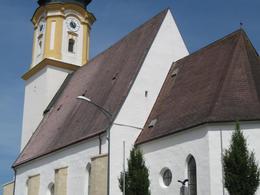Pfarrkirche St. Willibald
St. Willibald, Oberösterreich, Österreich
The turbulent history of the church and parish
It is not known exactly when the church was built, but it is thought to date back to the end of the 15th - beginning of the 16th century. It has always been a consecrated church for the Franconian Bishop Willibald. The stately, two-nave, late Gothic hall church has a so-called "Schöndorf vault type" (1476). At the beginning of the 18th century, after the turmoil of the War of the Spanish Succession, the Gothic church was renovated.
In 1715, the Schärding master mason Josef Hartl laid a new marble pavement, for which 900 stones were supplied from Hallein. In June 1732, lightning struck the tower of the church, causing severe damage to the tower and the church roof. The beautiful chimes, consisting of three bells, and the clock also melted. It was therefore necessary to demolish and rebuild the tower masonry and install a new belfry and dome. Furthermore, three bells were purchased, a new clock and a Spanish tower cross with a copper knob were also installed. In 1733, the ecclesiastical council of the time ordered the copper roofing of the tower, which was made by the Schärding coppersmith Franz Wiesmayer.
In 2004, the tower was painted in the Baroque style and the clock faces were repainted with Baroque hands.
The customs in the artistic life of the Electorate of Bavaria suggest that the rest of the tower was also the work of Schärding masters. The church soon became a destination for pilgrims. However, when they also came on Sundays and there was no service, there was grumbling and in 1752 the parish priest of Raab had to say mass every second Sunday. St Willibald only became a parish in its own right when Emperor Franz Josef II visited in 1782. The then Suben Abbey had to provide the priest and also pay for his accommodation and salary. Only the punishment of 100 ducats forced the provost to obey. In 1881, the church and tower were again damaged by a fire in the nearby inn. A complete renovation and refurbishment of the church - altars, Stations of the Cross, stained glass windows - was carried out between 1899 and 1912. In 1908 and 1909, the church was given new stained glass windows (made by Penner and Schürrer, donated by Maria Faschang and the Hintermaier family).
The church's patron saint, St Willibald, is depicted on the altarpiece. His two siblings, Wunibald and Walpurga, are depicted as life-size figures.
St Willibald was born around 700 in Wessex (southern England) and died on 7 July 787. Willibald lived in the monastery of Waltham (now Bishops-Waltham) from 705 to 720. Around 720, he left England and undertook pious journeys that took him to Rome, Palestine and other places of the Bible as well as Constantinople. He then spent ten years in Montecassino until he was appointed to the German mission under Boniface by Pope Gregory III in 739 and sent to Eichstätt. He was ordained a priest in 740 and a bishop in 741. Willibald founded Heidenheim Abbey in 752, the Solas cell in Solnhofen in 754 and took part in the Concilium Germanicum in 742/743 and the Synod of Attigny in 762. From Eichstätt, he developed a lively missionary activity among Bavaria, Franconia and Swabia.
The high altar
The altarpiece depicts St Willibald pointing to the crucifix. The painting is by Sebastian Schönhofer from Schärding and was created at the end of the 18th century. It was professionally renovated in 2006 by Peter Purkhart and Wolfgang Gruber. Since 1954, the two life-size figures of St Walpurga and St Wunibald, which were created around 1700, have flanked the altarpiece. The late Baroque tabernacle dates from the second quarter of the 18th century and was brought to St Willibald's from a chapel in Naarn. The altar table was purchased from a second-hand goods dealer from Prambachkirchen around 1960. In 2006, the entire high altar ensemble was restored by restorer Wolfgang Hebenstreit and financed by the Goldhaubengruppe St. Willibald.
The side altars
The side altars were redesigned in 1960-61 after the neo-Gothic superstructures were sold. However, the neo-Gothic altar tables from 1901 remained.
On the left side altar is a Madonna and Child (Queen of Heaven, third quarter of the 17th century), which comes from the Bründl Chapel in St Jakob. The tabernacle with twisted columns and a projecting cornice (18th century) comes from the parish church of Goldwörth (Urfahr district).
On the right side altar is the crucifixion group, the crucifix (second half of the 18th century) was purchased in 1913 as a mission cross for the parish church. The figures of Mary and John (third quarter of the 18th century) are from Esternberg.
The pulpit
It is a Josephine pulpit by the sculptor Thomas Jordan, which was made in the fourth quarter of the 18th century. The round basket features reliefs of the Good Shepherd as well as profile busts of St Peter and St Paul in the style of emperors' heads, while the sounding board features a tempietto and angels with the tablets of the law.
Saints Philip and Jacob
These two figures were also moved here from the Bründl Chapel of St Jacob in 1970. They are strongly Gothicised (first quarter of the 17th century).
Wooden gallery with paintings of the 14 Holy Helpers.
The wooden gallery, which was built at the beginning of the 20th century, is located in the west bay of the church. The late baroque paintings depict the 14 holy helpers. From the left: St Dionysius, Blasius, Erasmus, Georg, Christopher, Pantaleon, Vitus, Achatius, Eustachius, Cyriakus, Agidius, Katharian, Barbara and Margaretha.
The organ was built by Josef Breinbauer in 1836, modified by Leopold Breinbauer in 1898 and renovated in 1971 and 1998. In the walled-up western pointed arch opening of the tower is the "Mount of Olives" sculpture group, which was created by the Val Gardena sculptor Leopold Maroder in 1905. During the renovation in 2007, the group was cleaned and restored by restorer Hebenstreit with financial support from the local cultural association.
4762 St. Willibald
Phone +43 7762 2900
mobile +43 664 5166641
E-Mail r.windpessl@aon.at
Web www.sankt-willibald.at
http://www.sankt-willibald.at
Contact person
Ing. Rudolf Windpeßl
- always open (24/7)
- open to the public
Please get in touch for more information.



